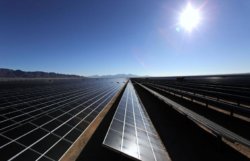When people think of solar power, they tend to think of panels on rooftops.
The US wind fleet averages out at about 33 percent CF, where it’s been more or less stuck for years. Turbines are getting taller, which improves CF, but they’re being installed in more and more suboptimal sites, which lowers CF; for now, it’s balancing out. The natural gas fleet is at about 26 percent CF. Note that this lumps together combined-cycle plants, which tend to have CFs up toward 57 percent, and open-cycle plants that are used primarily for “peaking,” which have CFs down around 7 percent. The average CF of all utility-scale solar (including PV and CSP) is about 19 percent. Here’s an EIA graph showing capacity factors over time: And here’s another that focuses on renewable energy capacity factors: Not exactly the upward sloping lines one might like. A new report from LBNL takes a deep dive into the CFs of new utility-scale solar PV plants (installed in 2014). The report finds that the average CF across all new PV plants is 27.5 percent, but the range among individual projects is crazy wide, from 14.8 to 34.9 percent. (Though they did find that most solar PV plants produce roughly what investors forecast.) The high end of that range, flirting with 35 percent, is really impressive — way better than what was possible even a few years ago. What makes for higher CFs for solar PV plants? The intensity of sunlight is the biggest factor, obviously. Beyond that, trackers, which change the orientation of panels throughout the day to follow the sun, are a big boost. Keeping the panels clean is important. And “inverter load” is important, though I won’t bore you by explaining it. Long story short, solar PV plants are performing predictably and improving their capacity factors over time. Big solar is about to get unstoppable Big solar used to be almost entirely driven by policy, mainly state renewable energy standards and federal tax credits. It has all but outgrown the first and will outgrow the latter over the next five years. It’s about to stand on its own two feet, outcompeting even rivals that are allowed to dump carbon emissions into the atmosphere for free. It won’t be long before the discussion about environmental benefits is moot — utilities will demand solar because it’s the cheapest power available. ...
Tags: Building Maintenance, Florida Rising Magazine

